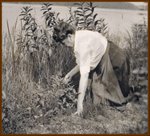I enjoyed showing the garden to Kylee; it was interesting to see the garden through her eyes. Sometimes all I see is what needs to be done--weeding, deadheading, redesigning. No matter what, though, I thoroughly love being there in the woods, along the water, in a garden.
I knew that there was one geocache at the site, as I talked to some geocachers last fall. I learned Saturday that there are two on the site. If this is your sport, don't look at the photos below because this cache is in a very distinctive place.
.
.
.
.
.
.
.
.
.
.
.
.
.
.
.
.
.
.

Here's Kylee honing in on the cache. Notice how another geocacher is leaning on the bole of this tree.

Here she is checking out the contents, and another view of the bole.
















